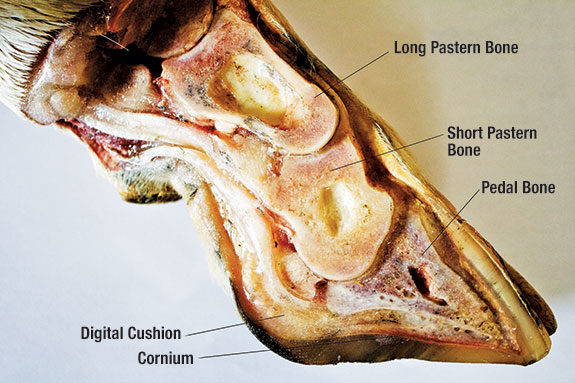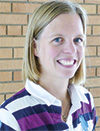Lameness is a common on-farm reason for culling cows. About 20 to 30 percent of cows in a herd are expected to become lame in any given lactation. A cow that is lame may not immediately show symptoms but eventually lies down longer, eats less and consequently produces less milk.
A study done in 2007 calculated this to represent a loss of $200 to $400 considering milk production alone. In addition it found that many producers are aware of only one in four cows that are lame due to the probable number of subclinical cases.
Understanding hoof anatomy
To understand hoof injuries we need to understand hoof anatomy. As seen in the photo, there are three main bones: the pedal bone (P3), a short pastern bone (P2) and the long pastern bone (P1). The P3 is connected to two tendons – the extensor tendon and the flexor tendon.
Together they swing the bones inside of the foot during locomotion. The pressure of the weight on these bones is cushioned by a layer of fat that acts as a shock absorber called the digital cushion.
The cornium is responsible for the horn growth and is often affected if the thickness of the digital cushion is reduced due to the passing of hormones such as relaxin. This hormone travels around the entire body during time of calving to soften the cervix and relax the uterine muscles in preparation for birth.
Additionally, changes in body score condition during peak lactation can cause fat stores to be mobilized and also affect the thickness of this cushion. When the digital cushion thins out, the P3 starts to press down onto the cornium, affecting new growth.
Weight distribution
Ideally you want a cow to walk with her weight distributed equally on both legs, preventing her from overloading the joints, tendons and hooves.
A cow’s front legs bear 60 percent of the weight and her back legs 40 percent. Her back feet are used for pushing herself along, as her front feet steer her in the direction she is heading toward.
Since her back legs are used for pushing, her outer claws bear more weight than the inner claw, where the opposite is true for her front feet.
The claw with more weight actually grows faster and so the load on that claw is increased. For this reason, the weight-bearing claw, also known as the lateral claw, usually appears larger than the non-weight-bearing claw, or medial claw. It therefore makes sense that the lateral claw is always on the inside of the front feet and on the outside of the hind feet.
In addition to their bodyweight pushing down, hard surfaces increase the effect of the downward force and additionally result in increased growth and potentially cause claw disorders as the weight distribution changes.
Locomotion and hoof health
It is important to diagnose hoof problems early to prevent major losses. Although it is time-consuming, gait scoring, done on a regular basis, can aid in identifying behavior displayed by lame cows. Gait scoring is done by looking at the cow’s walking ability.
A gait score will range from one to five, where a cow with a gait score of one walks robustly with equal timing between hoof placement, and hind hooves land on or ahead of the front hoof prints. Her head is steady and back is kept flat when walking.
A cow with a score of three is still able to walk but with some limitations. She has a slightly arched back and tends to short-step, as her hind hoof prints no longer are placed on the front hoof prints, causing the timing of her steps to become unequal and her head to swing slightly.
By the time a cow receives a score of five, she is visibly in pain, her back obviously arched and her ability to move around has been limited due to her injury for quite some time. Her steps are now very unequal, falling extremely short of her front hooves, and her head movement is jerky as she is reluctant to put any weight on her limbs.
The easiest way to gait score is by using a flat, non-slippery and narrow pathway where cows will pass by one by one. Remember that, for some cows, a full udder may affect their walk and thus after milking would be ideal.
Technology such as pedometers can aid in finding lame cows. Although a pedometer’s main purpose is to show heats, it also indirectly shows lameness in the herd. Various heat detection technologies exist and may aid in revealing possible hoof health issues as cows decrease their activity.
Importance of nutrition
One cause often noted to lead to cow lameness is a feeding program that may lead to rumen acidosis and, thus, laminitis. This is prevented by ensuring a proper balance between starch and digestible fiber while having enough roughage consumed to stimulate good rumen activity.
Vitamins such as biotin have shown to increase the strength of the hoof horn, reducing lameness. Likewise, amino acid-bound minerals also known as chelated minerals have shown to reduce lameness.
Chelation is a process that allows formation of organic minerals, where the minerals are bound to a group of amino acids or peptides to mask the chemical charge that a mineral has.
Minerals such as zinc and copper have a plus charge on them, meaning they are capable of binding to substances with a negative charge in the rumen. When this occurs, the chemical structure is now too large to be absorbed and is discarded in the manure.
Chelated minerals do not bind to these negatively-charged particles, thus they are more available to the animal. This is particularly important for zinc and copper as they aid in growing a hard hoof.
Adequate amounts of trace minerals can positively influence lameness in dairy cows. Zinc is an essential trace mineral which, amongst other functions, plays a vital role in hormone secretion and generates keratin, a fibrous protein important in the hardness of the hoof and wound healing.
Copper is significant in the production of claw horn, and a deficiency can affect the synthesis of keratin and, thus, the growth of horn tissue. Manganese is also vital to healthy hoof formation and bone growth.
Providing these minerals in an inorganic form, while following the National Research Council guidelines for trace minerals, allows the animal to maximize uptakes.
Sufficient trace minerals, understanding hoof anatomy and the ability to distinguish regular and irregular activity allows for early identification and quick action, which is key in reducing lameness and its effect on your bottom line: profitability. PD
References omitted due to space but are available upon request. Click here to email an editor.
PHOTOS
TOP RIGHT: Sufficient trace minerals, understanding hoof anatomy and the ability to distinguish regular and irregular activity allows for early identification and quick action, which is key in reducing lameness. Photo courtesy of Anita Heeg.

Anita Heeg
Dairy Specialist
Alltech Canada







